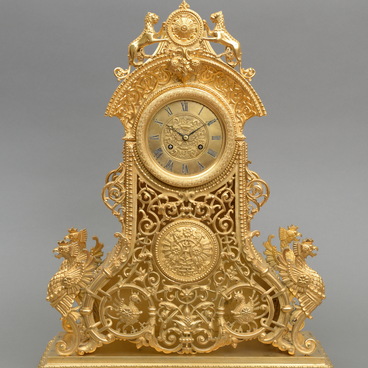The dishware of the Grand Duke Konstantin Nikolaevich (younger brother of the Emperor Alexander II) with the monogram ‘VKKN’ is made in the Russian-Byzantine style. The dishware was made in 1848 on Grand Duke’s Konstantin Nikolaevich (1827-1892) wedding with Princess Frederica of Saxe-Altenburg, in Orthodoxy Alexandra Iosifovna (1830-1911), and was intended for ceremonial receptions of the grand ducal family in their St. Petersburg residence — the Marble Palace.
Designed for 48 persons, the dishware included a dining part with tea and coffee utensils, a dessert part, as well as ordinary table and tea sets for 100 people. The Constantine’s dishware was designed by the famous artist and archaeologist Fyodor Solntsev (1801-1892). The decor of the dishware, developed on a combination of bright red and green with golden veinlets, resembles ancient Russian enamels. Items in this set are decorated with cartouches depicting a two-headed eagle holding maps of the four seas. This image symbolized the high military rank of Grand Duke Konstantin Nikolaevich — general admiral of the Russian fleet.
Fyodor Solntsev is a very important person in the formation of the ‘Russian style’. The artist played a significant part in the popularization and study of the culture of Ancient Rus, in understanding the origins of national art.
In 1830, on the highest order and instructions of Alexei Olenin, a member of the State Council, Solntsev went on a trip around Russia ‘to copy our ancient customs, attire, weapons, church and royal utensils, belongings, horse harness, other items “. In 1853, based on the materials collected during the trip, he published the album Antiquities of the Russian State, which included more than 700 color illustrations, among others sketches of ancient cathedrals, churches, treasures of the Kremlin Armory, details of military weapons and so on.
In his work with the Imperial Porcelain Factory, Fyodor Solntsev was one of the first to introduce the motives of Russian-Byzantine ornament. The artist also participated in the design of the interiors of the Grand Kremlin Palace, built by the architect Konstantin Thon in 1846.
Designed for 48 persons, the dishware included a dining part with tea and coffee utensils, a dessert part, as well as ordinary table and tea sets for 100 people. The Constantine’s dishware was designed by the famous artist and archaeologist Fyodor Solntsev (1801-1892). The decor of the dishware, developed on a combination of bright red and green with golden veinlets, resembles ancient Russian enamels. Items in this set are decorated with cartouches depicting a two-headed eagle holding maps of the four seas. This image symbolized the high military rank of Grand Duke Konstantin Nikolaevich — general admiral of the Russian fleet.
Fyodor Solntsev is a very important person in the formation of the ‘Russian style’. The artist played a significant part in the popularization and study of the culture of Ancient Rus, in understanding the origins of national art.
In 1830, on the highest order and instructions of Alexei Olenin, a member of the State Council, Solntsev went on a trip around Russia ‘to copy our ancient customs, attire, weapons, church and royal utensils, belongings, horse harness, other items “. In 1853, based on the materials collected during the trip, he published the album Antiquities of the Russian State, which included more than 700 color illustrations, among others sketches of ancient cathedrals, churches, treasures of the Kremlin Armory, details of military weapons and so on.
In his work with the Imperial Porcelain Factory, Fyodor Solntsev was one of the first to introduce the motives of Russian-Byzantine ornament. The artist also participated in the design of the interiors of the Grand Kremlin Palace, built by the architect Konstantin Thon in 1846.
